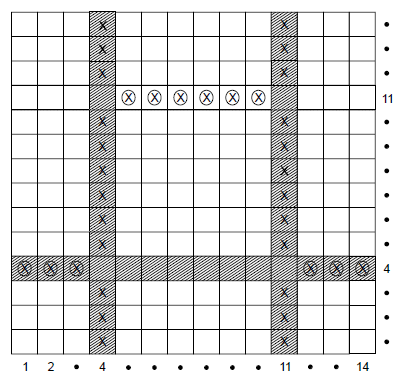MOCK LENO WEAVES:
Mock lenos, also known as imitation lenos are a variety of weaves of ordinary construction which produce effects that are similar in appearance to the gauze or leno styles obtained with the aid of doup mounting. These weaves are generally produced in combination with a plain, twill, satin or other simple weaves or even with brocade figuring, to produce striped fabrics, which bear a very close resemblance to true leno fabrics. Two kinds of structures are produced by the weaves,
- Perforated fabrics which imitate open gauze effects
- Distorted thread effects which imitate spider or net leno styles.
PERFORATED FABRICS:
These are constructed by reversing a small unit of the weave. The weaves are in sections and tend to oppose each other. The outer threads of adjacent sections tend to be forced apart. The manner of interweaving in each section permits the threads to readily approach each other. Fig. 10.1 shows the various types of perforated fabric designs.
 |
 |
| Design of perforated fabric |
Figures A, B and C show the 3 ¥ 3, 4 ¥ 4 and 3 ¥ 5 imitation gauzes. The warp threads run in groups with a space between, and are crossed by weft threads which are grouped together in similar manner. The designs A, B and C are dented 3, 4 and 5 ends respectively per split as shown above the plans. arrows above the denting plans indicate the positions of the empty splits.
The DISTORTED THREAD EFFECTS:
The weaves of this category are so arranged to distort certain threads in either the weft or the warp, or in both weft and warp. The distorted thread effects are shown in Figs. 10.2 and 10.3.
 |
| Design of warp way distorted mock leno weave |
 |
| Design of weft way distorted mock leno weave |
In Fig. 10.2, the ground structure is plain weave, and the fourth and eleventh ends, which are distorted, float over all the plain picks, but pass under the fourth and eleventh picks. The latter float over one group of plain ends, and under the next group in alternate order. The distorted ends are placed on a separate beam and are given in more rapidly than the ground ends and hence they are drawn towards each other where the picks four and eleven, float over the ground ends. As the latter floats occur in alternate order, the ends are drawn together in pairs, and then separated, as indicated by the zig zag lines.
The distorted warp effects are chiefly used in combination with other weaves in stripe form. When used in stripe form the ends which form the zig zag effect should be somewhat crowded in the reed.
Figure 10.3, shows a distorted weft design. The design is arranged with plain ground similar to that in fig. 10.2. The floating ends pass over all the distorted picks, and alternately over the ground picks between. Therefore the distorted picks, which float over all the ground ends, are alternately drawn together and separated, as shown by the zig zag lines of Fig. 10.3.
END USES OF MOCK LENOS:
Mock lenos find uses in canvas cloths, cheap fabrics for window curtains, light dress fabrics, blouses, aprons etc. In many cases, they are generally employed in combination with other weaves.


Thank you so much..this helped me in my exam preparation a lot :D
ReplyDeletestay blessed
DeleteCan u help me for understanding this weave?
DeleteNice to help in exam preparation
ReplyDeleteIs distorted thread effect available???
ReplyDeleteNice for
ReplyDeletehelp...
Thank you so much...this is very helpful for my exam
ReplyDeleteThnks
ReplyDelete18x18 repeat size distorted thread effect drafting plan plz>>.
ReplyDeleteMock leno 10×10 design plz
ReplyDeleteThe PP laminated woven fabric suppliers in Ahmedabad is highly durable, lightweight, and versatile. Ideal for packaging, agriculture, and construction applications, it offers excellent strength and resistance to wear and tear. Its recyclable nature makes it an eco-friendly choice for various industries. A reliable and cost-effective material!
ReplyDeletePost a Comment